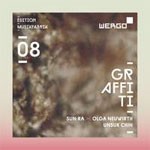2(I=picc,II=afl).2(II=corA).2(I=Ebcl,II=bcl).1(=dbn)-2.2.1.1-perc(3):vib/tubular chimes/5SD(2sm,4med,2lg)/cym(sm)/glsp/mark-tree/5tgl(med,sm)/timp/tamb/harmonica/xyl/flex/cyms/crot/pitched gongs/2pop bottles/cencerros/marimba/BD/4tpl.bl/4tom-t/TD/3susp.cym/thundersheet/whip-harp-pft(=cel)-strings(4.0.2.2.1)
Abbreviations (PDF)
Boosey & Hawkes
Most of us, when confronted with the term 'graffiti', are likely to associate it with the rather desolate wall scrawlings all over our urban landscapes. However, this is far from being the whole picture: graffiti is an age-old form of artistic expression, which – unexpectedly, and without ever attempting at being 'high art' – can be very creative. No lesser artists than Klee, Miró, Dubuffet or Picasso were stimulated by it (the latter painting examples himself on Parisian walls). In our time, there exists the interesting and controversial phenomenon of Street Art, which has occasionally succeeded in criticising the commercialisation and uniformisation of cities in a witty manner. At their best, street artists have been able to thwart the expectations created by omnipresent mass media and by advertising – one can find some particularly remarkable examples in metropolises such as Berlin, Paris or New York.
Though this phenomenon was the initial stimulus for my ensemble work Graffiti, it finally branched into rather different directions and the music is only very loosely, if at all, connected to Street Art. It is neither illustrative nor is it programmatic; what remained from the initial creative nucleus is little more than the title and the striking dialectic between primitivism and refinement, which captured my attention in some of the most noteworthy examples of Street Art. My main idea, at the end, was to compose music which is not restricted as to time or place, and which offers strong contrasts between highly different modes of expression.
The movements' headings give a hint of the changing patterns and structures of the music. The first movement, Palimpsest, is – as its title says - polydimensional and many-layered: one can hear allusions to a multiplicity of styles, which have been taken from their original context and juxtaposed in a kaleidoscopic manner.
The second movement, Notturno urbano, forms a strong contrast to the hyperactive previous movement. It starts with distant and gradually approaching bell-like sounds, from which the whole movement's musical material is being derived: from their resonance simple intervallic relations emerge, which are being overwhelmed by more and more instruments. As a result, the music oscillates between simplicity and highly complex micropolyphony. The instruments are often used in an unconventional way: the winds as well as the strings employ extended techniques, which contributes to the aloofness and the mysteriousness of this movement.
The third, highly virtuosic, movement, is a kind of an 'urban passacaglia' (the name of this musical form actually derives from the Spanish "pasar una calle", i.e. "to walk along a street".) Formally, the passacaglia plays a central role throughout the movement: it consists of eight incisive chords, which are being played over and over again by the brass, albeit always in a different manner. Two worlds collide in this movement: the brass attacks are commented upon by flitting interjections of different instruments, which are highly varied in character and length. These fragmentary comments are being constantly interrupted by the brass passacaglia.
As a whole, the musical language of Graffiti shifts between roughness and refinement, complexity and transparency; it is rich in contrast and labyrinthine, neither tonal nor atonal. Graffiti calls for great agility, virtuosity and constant changes of perspective from the musicians; each instrument is being treated as a soloist.
Graffiti was jointly commissioned by the Los Angeles Philharmonic Association, the Barbican, musikFabrik, and Orchestra Ensemble Kanazawa. It was premiered by the Los Angeles Philharmonic New Music Group under the baton of Gustavo Dudamel at the Walt Disney Concert Hall in Los Angeles.
Unsuk Chin, 2013
"Unsuk Chin’s multi-layered Graffiti celebrated the idea of street art, from primitive to refined, labyrinthine to stark. Dense, skittering strings in the first movement, cascades of tubular bells and gongs in the second and urgent brass chords in the final "passacaglia" created a work of singularity and authority. Hers is a rare voice which commands your attention."
The Observer
"…Chin’s piece begins with unpredictable busy, flickering inner activity… [she] also considers the political implications of graffiti, which can be both liberating and threatening. The slow movement, Notturno Urbano, is darkly mysterious, while the final section, said to be a passacaglia, seemed to bring a new strange instrumental sound around every startling corner."
Los Angeles Times

Ensemble Musikfabrik / Peter Rundel
Wergo WER 6861 2

